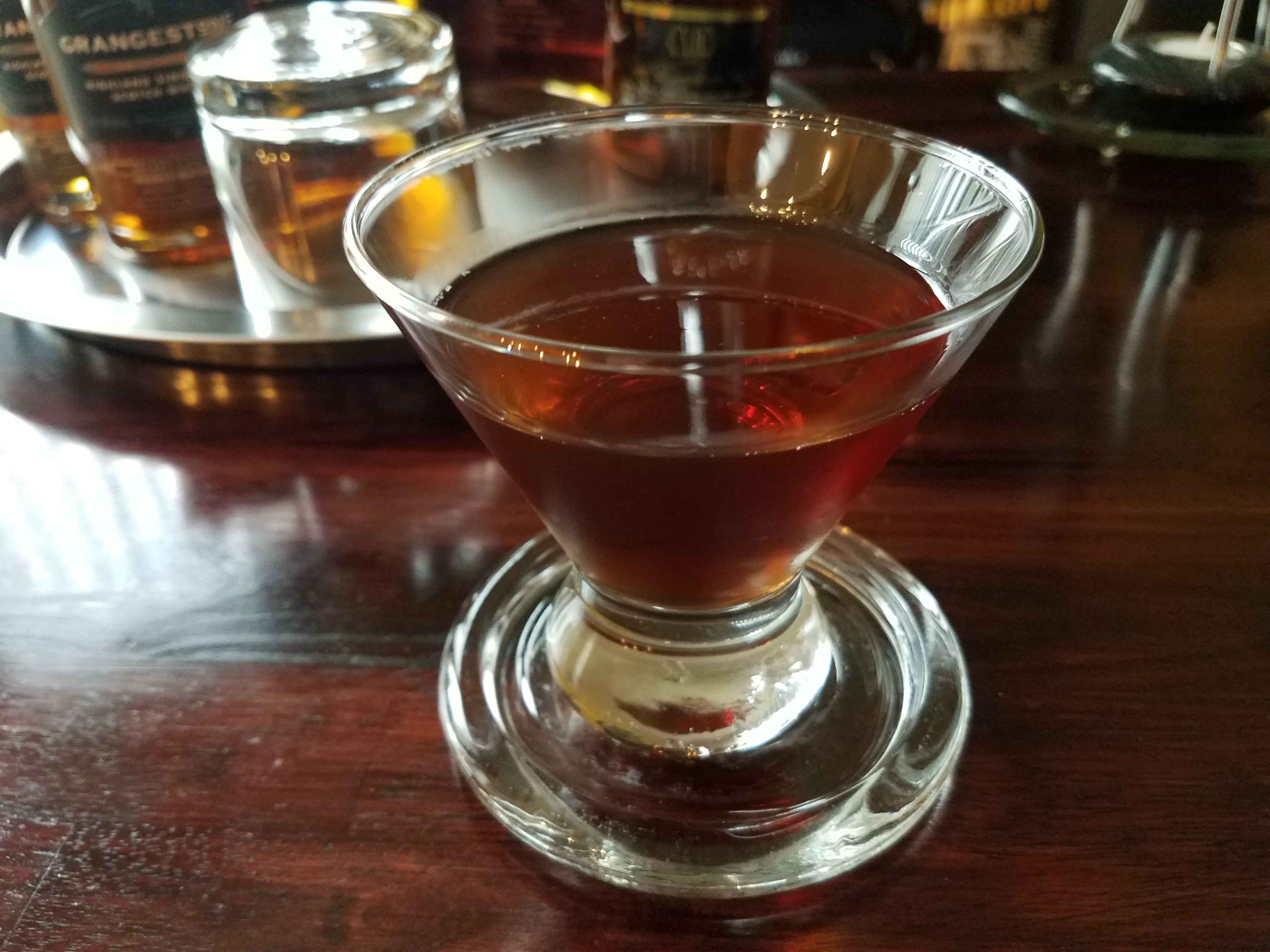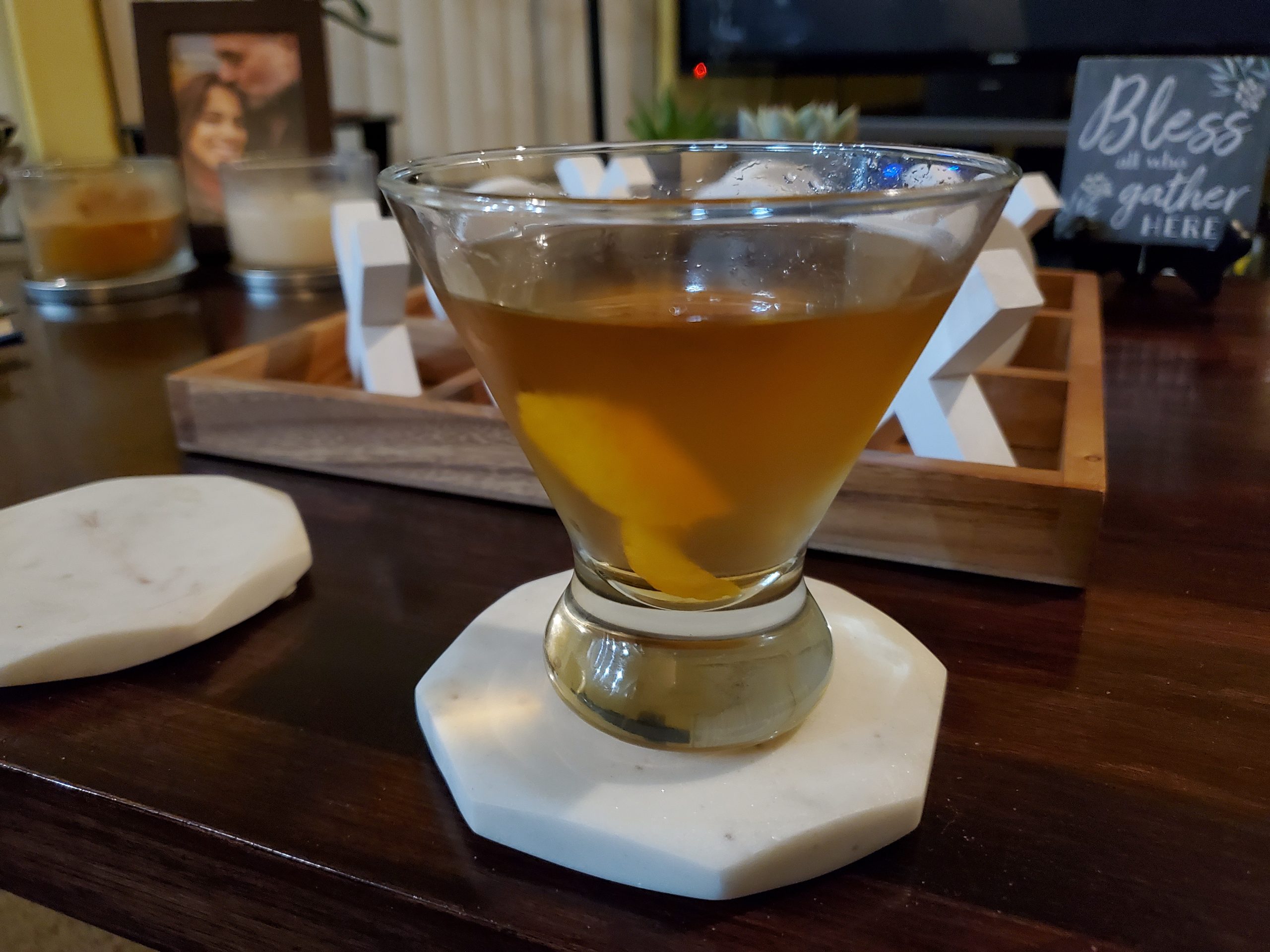
Let’s celebrate tonight’s happy hour with a century old cocktail that seems like a riff on the venerable Manhattan, but truly stands on its own. This combination of rye whiskey and sherry with a splash of orange/cognac liqueur creates a uniquely complex set of flavors. Depending on the type of sherry used, this cocktail could range from a slightly biting dry to a silky smoky sweetness. Unfortunately, all I had on hand was a cream sherry – a notoriously sweet sherry – and the resulting drink was indeed sugar forward but nonetheless enjoyable. Since I like Manhattans, there was more than a strong chance I would like this drink. And I do (even with the cream sherry!)… so now to collect a few different types of sherry and give them all a try!
- 1½ ounces Pendleton 1920 rye whiskey
- 1½ ounces sherry (see Notes for specific sherry tasting profiles)
- ¼ ounce Grand Imperial
- 2 dashes Angostura bitters
- Chill a cocktail glass.
- Add ice, rye, sherry, Grand Imperial and Angostura bitters to a mixing glass.
- Stir until well chilled, about 20 seconds.
- Strain into the chilled cocktail glass and serve.

Chill a cocktail glass. Add ice, rye, sherry, Grand Imperial and Angostura bitters to a mixing glass. Stir until well chilled, about 20 seconds. Strain into the chilled cocktail glass and serve.

Enjoy!
Share this:
- Click to share on Facebook (Opens in new window)
- Click to share on Pinterest (Opens in new window)
- Click to share on Twitter (Opens in new window)
- Click to share on Tumblr (Opens in new window)
- Click to share on Reddit (Opens in new window)
- Click to share on WhatsApp (Opens in new window)
- Click to email a link to a friend (Opens in new window)
- Click to print (Opens in new window)
Related Posts
Burnt Fuselage
From Harry MacElhone’s 1927 book, Barflies and Cocktails, comes this smooth landing of…
Share this:
- Click to share on Facebook (Opens in new window)
- Click to share on Pinterest (Opens in new window)
- Click to share on Twitter (Opens in new window)
- Click to share on Tumblr (Opens in new window)
- Click to share on Reddit (Opens in new window)
- Click to share on WhatsApp (Opens in new window)
- Click to email a link to a friend (Opens in new window)
- Click to print (Opens in new window)
Longshoreman
Here’s another Manhattan riff from the team at Liquor.com. The Longshoreman drops…
Share this:
- Click to share on Facebook (Opens in new window)
- Click to share on Pinterest (Opens in new window)
- Click to share on Twitter (Opens in new window)
- Click to share on Tumblr (Opens in new window)
- Click to share on Reddit (Opens in new window)
- Click to share on WhatsApp (Opens in new window)
- Click to email a link to a friend (Opens in new window)
- Click to print (Opens in new window)
7 COMMENTS
Leave A Comment
If you like the recipe or have made the dish, please let me know your thoughts!Cancel reply
This site uses Akismet to reduce spam. Learn how your comment data is processed.



Nancy Kirk | 1st Dec 17
Really enjoy your posts. I feel like your recipes can be made by a regular person. I would love to have a pantry, fridge and freezer list: 1) items to always have on hand 2) items to purchase at certain times of the year and 3) items to be purchased for specific recipes. Or any better system of organization you recommend.
Thanks, Nancy Kirk
Kent | 2nd Dec 17
Hi Nancy!
These are great questions and I will answer them with an upcoming post. You have really got me thinking now!
Stay tuned and I’ll get this rolling soon!
Kent
Nancy Kirk | 4th Dec 17
Thank you for the pantry list. I saved it on the computer and will add items each time I shop, and will keep reading to learn how to use some of them. I have a short list of unfamiliar items on the list and will send those soon to see if you could do short descriptions of the tastes and probable uses. Blessings. Nancy
Kent | 5th Dec 17
Nancy, I am glad the Pantry Basics post has been of help to you. By all means let me know if any ingredient or item is unfamiliar. I am here to help!
Nancy Kirk | 10th Jan 18
Hi Kent. I like the idea of Sous vide, but have never seen it done. You mention using a reclosable bag. Is this just a plain old zip loc, or some special type of bag. If it is something special — where do you get them? Is there a top temperature? and how do you tell the temperature of the water. I have a meat thermometer, but is that what you use in water? Just need a little more information. Also, if using a plastic bag, how do you keep it from melting against the side of the pan?
Kent | 11th Jan 18
Hi Nancy,
Sous vide is a cooking method that uses a temperature controlled water bath. It requires special equipment – either a sous vide immersion circulator and a standard pot or a counter top water oven. Think of this equipment as being like a blender, mixer, or food processor in your kitchen. Each of those devices are used for certain ingredient preparation. A sous vide device is exactly the same. As I mentioned before, the sous vide cooking method uses tightly controlled water temperature to gently cook vacuum sealed food items. This process cannot be accomplished on a stove top – the heat would fluctuate too much. When preparing the food items, you can use zip top style recloseable bags or food sealer type vacuum bags (Seal a Meal, Food Saver, etc).
Here is a link to an accurate and curated description of sous vide cooking – https://en.wikipedia.org/wiki/Sous-vide – including a video of the process. Let me know if you still have any questions.
Kent
Nancy Kirk | 11th Jan 18
Thank you. I see the term sous vide on line and on cooking shows and never understood it. Probably won’t happen at our house — there is barely room on the kitchen counter for a toaster. But hope that some day I will get to taste something wonderful cooked this way.